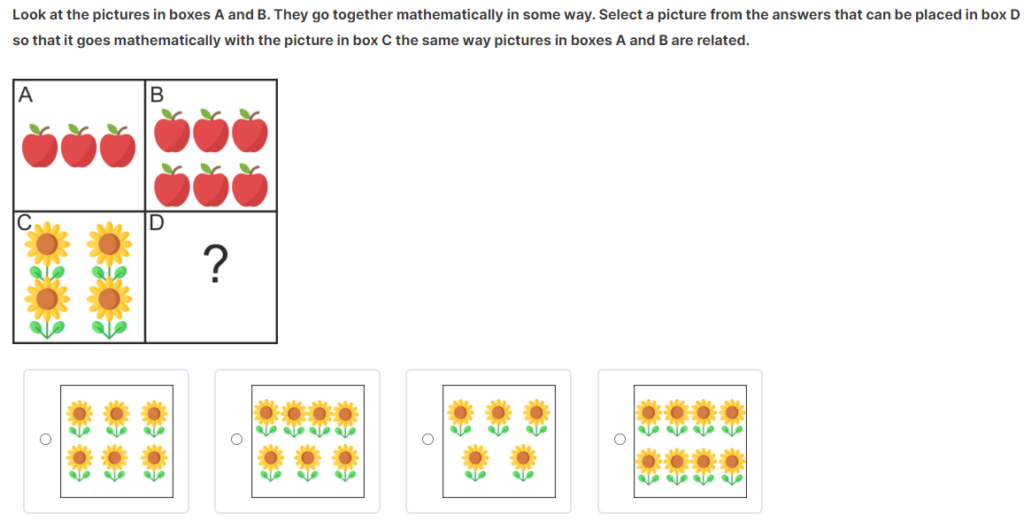The CogAT Quantitative Battery is an essential component of the Cognitive Abilities Test (CogAT) designed to assess students’ quantitative reasoning abilities. It consists of three subtests: Number Analogies, Number Puzzles, and Number Series.
Number Analogies
Number Analogy is an integral part of the Cognitive Abilities Test (CogAT) that assesses a student’s ability to recognize relationships between numbers and apply logical reasoning. This section of the test helps evaluate a student’s quantitative and mathematical reasoning skills. The format of Number Analogy questions in CogAT evolves as students progress through different levels to match their cognitive development.
At the lower levels of CogAT, typically administered to younger students, Number Analogy questions are often presented in an image-based format. Students are shown pairs of images or symbols that follow a certain pattern or relationship in terms of numbers or quantities. They are then asked to identify an image or symbol from a list of options that adheres to a similar pattern. For example, they might see a pair of images with one containing three apples and the other containing two apples, and they would need to select a pair with a similar numerical relationship, such as one with four and three apples.
Below is an example of a question designed for students at the lower levels of the CogAT.

As students advance to higher levels of CogAT, which are typically given to older students, Number Analogy questions transition to a text-based format. Instead of images, students are presented with pairs of words or numerical expressions that are related in terms of numbers or mathematical operations. They are then required to identify a pair from a list of options that follows a similar numerical relationship. For instance, they might encounter a pair like “5 + 3” is to “8” and be tasked with selecting a pair that follows a similar numerical analogy, such as “6 – 2” is to “4.”
This shift from image-based to text-based questions reflects the development of more advanced mathematical and quantitative reasoning skills as students progress through their education. Number Analogy in CogAT is a valuable tool for assessing a student’s ability to recognize numerical patterns, apply mathematical concepts, and think logically in quantitative contexts. It assists educators and parents in tailoring educational strategies to match the cognitive abilities and needs of individual students at different stages of their academic journey.
Number Puzzle
Number Puzzle is a key component of the Cognitive Abilities Test (CogAT) designed to evaluate a student’s mathematical reasoning and problem-solving abilities. This section of the test assesses a student’s capacity to recognize patterns, relationships, and solve numerical puzzles. The format of Number Puzzle questions in CogAT undergoes a transformation as students progress from lower to higher levels, aligning with their cognitive development.
At the lower levels of the CogAT, typically administered to younger students, Number Puzzle questions are often presented in an image-based format. Students are shown visual representations of numerical patterns or sequences, and they are asked to identify the missing piece in the pattern. This might involve recognizing the progression of numbers or quantities in a series of images. For example, they might see a sequence of images showing a pattern like one apple, two apples, three apples, and then need to select the correct image to complete the sequence, which would depict four apples.
Below is a slightly different example of a question designed for students at the lower levels of the CogAT.

As students move up to higher levels of the CogAT, typically given to older students, Number Puzzle questions shift to a text-based format. Instead of visual images, students are presented with numerical patterns or sequences in the form of words or numerical expressions. They are required to identify the missing piece in the pattern based on the rules governing the sequence. For instance, they might encounter a series of numbers like “2, 4, 6, __” and be tasked with determining the missing number to complete the pattern, which would be “8.”
Number series
Number Series is a significant component of the Cognitive Abilities Test (CogAT), designed to evaluate a student’s ability to identify numerical patterns and sequences. This section of the test assesses mathematical reasoning and problem-solving skills. The format of Number Series questions in CogAT varies as students progress from lower to higher levels, aligning with their cognitive development.
At the lower levels of the CogAT, which are typically administered to younger students, Number Series questions are often presented in an image-based format. Students are shown visual representations of numerical patterns or sequences in the form of images or symbols. They are then asked to recognize the pattern and identify the missing piece in the series. For example, they might see a sequence of images depicting a pattern like one, two, three, and need to select the correct image to continue the sequence, which would represent four.
Below is a different example of a question designed for students at the lower levels of the CogAT.

As students advance to the higher levels of the CogAT, typically given to older students, Number Series questions transition to a text-based format. Instead of visual images, students are presented with numerical patterns or sequences in the form of words or numerical expressions. They are required to identify the missing number in the series based on the underlying rules governing the sequence. For instance, they might encounter a series like “2, 4, 6, __” and be tasked with determining the missing number to continue the pattern, which would be “8.”

